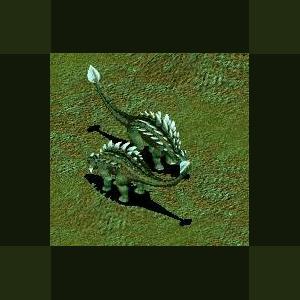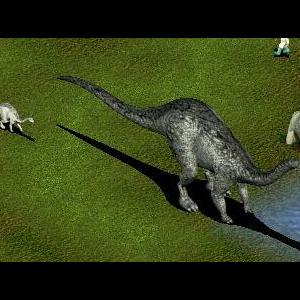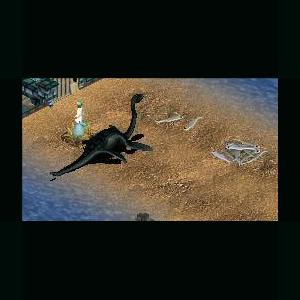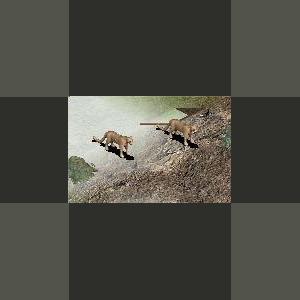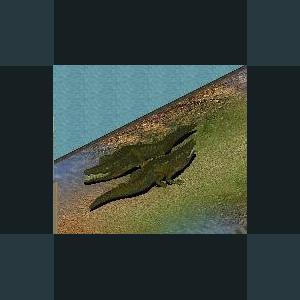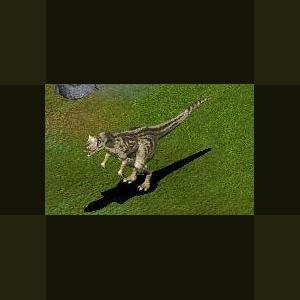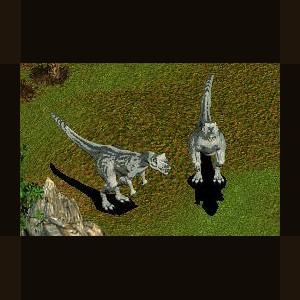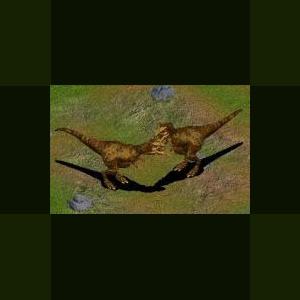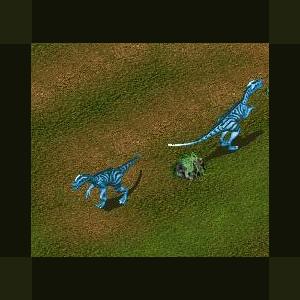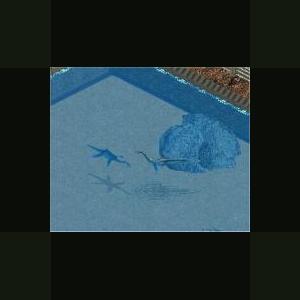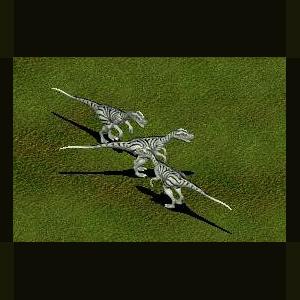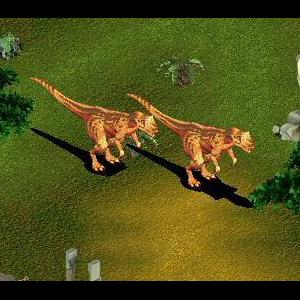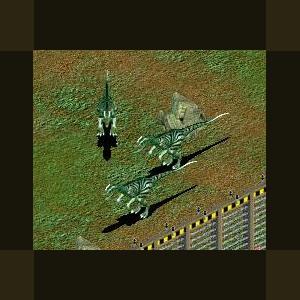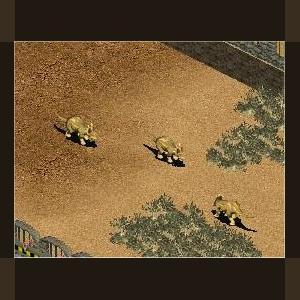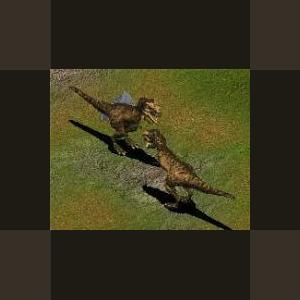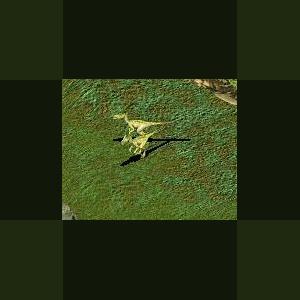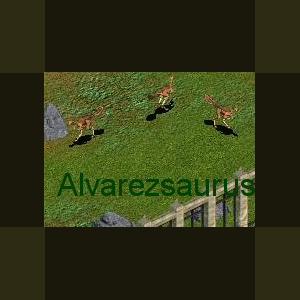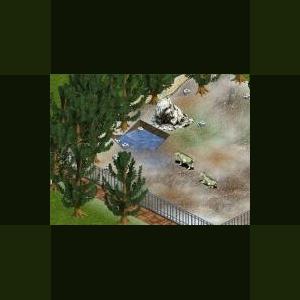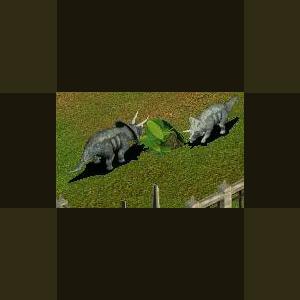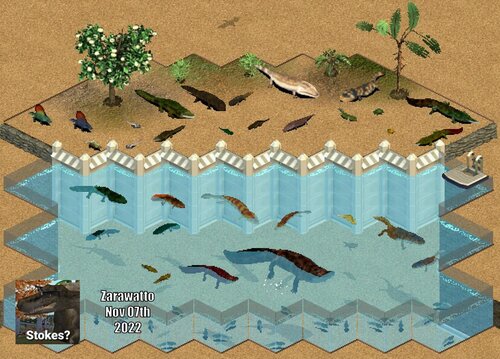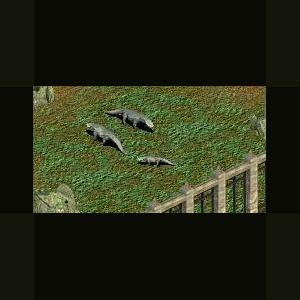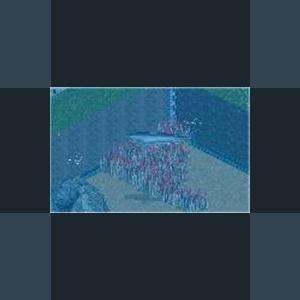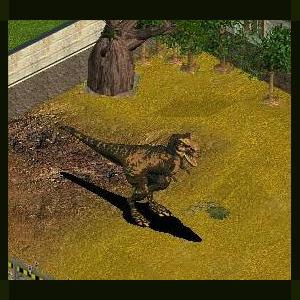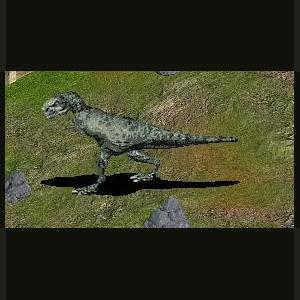Dinosaurs
Creatures from another age
241 files
-
Bissektipelta by Moondawg
By Guest
Bissektipelta is an ankylosaurid dinosaur from the Upper Cretaceous of Uzbekistan. The holotype and only known specimen was collected from the Bissekty Formation (lateTuronian-Coniacian).
The holotype consists of a braincase and incomplete skull roof, along with isolated teeth and osteoderms. Originally, this material was referred to the genus "Amtosaurus", but was reassigned to a new taxon when that genus was declared a nomen dubium. Bissektipelta is presently monospecific, containing only B. archibaldi. The holotype was collected in September of 1998 by the joint Usbek-Russian-British-American-Project. This specimen can be distinguished from "A. magnus" in having three exits for N. hypoglossus instead of two, by the lesser angle between ventral surfaces of basisoccipital and basisphenoid, and by the more caudally situated basispterygoid processes.
420 downloads
Updated
-
Argentinosaurus by Moondawg
By Guest
Argentinosaurus (meaning "Argentina lizard") was a herbivorous sauropod dinosaur genus that was quite possibly the largest, heaviest land animal that ever lived. It developed on the island continent of South America during the middle of the Cretaceous Period (around 100 million years ago), after all of its more familiar Laurasian Jurassic kin — like Apatosaurus — had long disappeared.
Not much of Argentinosaurus has been recovered: just some back vertebrae, tibia, fragmentary ribs, and sacrum. One vertebra had a length of 1.3 meters and the tibia was about 155 centimeters (58 inches). However, the spectacular proportions of these bones and comparisons with other sauropod relatives allow paleontologists to estimate the size of the animal. Early reconstructions estimated Argentinosaurus at 35 meters (115 ft) in length and a weight of perhaps 80 to 100 tonnes. More recent estimates based on Saltasaurus, Opisthocoelicaudia and Rapetosaurus suggest sizes around 22-26 meters (72 - 85 ft).[1] It is the largest dinosaur for which there exists good evidence. Although it might have been smaller than Bruhathkayosaurus, which may have reached 44 meters (144 ft) in length and weighed 180 tons (however like Argentinosaurus it has been estimated shorter, at 28-34 meters (92-112 ft)), as well as the poorly known Amphicoelias fragilimus, which may have been up to 60 meters (200 ft) long, these estimates cannot be validated due to lack of evidence.
Vast wings on the vertebrae suited the attachment of massive muscles
The type species of Argentinosaurus, A. huinculensis, was described and published (by the Argentinian palaeontologists José F. Bonaparte and Rodolfo Coria) in 1993. Its more specific time-frame within the Cretaceous is the Albian to Cenomanian epochs, 112.2 to 93.5 million years ago. The fossil discovery site is in the Río Limay Formation in Neuquén Province, Argentina
Argentinosaurus is featured prominently in the permanent exhibition Giants of the Mesozoic at Fernbank Museum of Natural History in Atlanta, Georgia, USA. This display depicts a hypothetical encounter between Argentinosaurus and the carnivorous theropod dinosaur Giganotosaurus. Contemporary fossils of Cretaceous Period plants and animals are included in the exhibition, including two species of pterosaurs, providing a snapshot of a prehistoric ecosystem in what is now the modern Patagonia region of Argentina. At 123 feet (37 m) long, this skeletal reconstruction represents the largest dinosaur mount ever to be assembled.
601 downloads
0 comments
Updated
-
Hydrotherosaurus by Moondawg
By Guest
Hydrotherosaurus (meaning "water beast lizard") is an extinct genus of elasmosaurid plesiosaur from the Upper Cretaceous (Maastrichtian) of Fresno County, California, measuring up to 13 m in length.
288 downloads
Updated
-
American Lion by Moondawg
By Guest
The American lion (Panthera leo atrox) also known as the North American or American cave lion, is an extinct feline known from fossils.
It was one of the largest subspecies of lion to have ever existed, comparable in size to the Early Middle Pleistocene primitive
cave lion Panthera leo fossilis and was about 25% larger than the modern African lion.
The American lion is an extinct animal which originated in North America and went on to
colonize part of South America as part of the Great American Interchange. The body length
of the American lion is estimated to have been 1.6-2.5 m (5.25-8.20 feet). Thus it was
comparable in size to its close relative, the extinct lion, Panthera leo fossilis, or the
modern species of Siberian tiger, but still smaller than their contemporary competitor for
prey, the Giant short-faced bear, which was the largest carnivoran of their era.
Approximately one hundred specimens of American lions have been recovered from the La Brea
Tar Pits, in Los Angeles, so their body structure is well known. The features and teeth of
the extinct American lion strongly resemble modern lions, but they were considerably larger.
South of Alaska, the American lion first appeared during the Sangamonian (the last
interglacial). After that it was widespread in the Americas from Alaska to Peru, although
it was absent from eastern North America and peninsular Florida. As did many other large
mammals, it went extinct at the end of the Pleistocene, about 10,000 years ago. By then
the American lion was one of the abundant Pleistocene megafauna, a wide variety of very
large mammals who lived during the Pleistocene. Remains are most common in the Yukon and
from the La Brea Tar Pits.
527 downloads
0 comments
Updated
-
DinoCroc by Moondawg
By Guest
DinoCroc
Dinocroc is a 2004 horror film about a prehistoric carnivore, Sarcosuchus imperator. It is resurrected in a genetics laboratory after being mixed with a modern day crocodile, resulting in a hybrid monstrosity that has a lot in common with the Spinosaurus. It escaped the lab in a run-of-the-mill American town, and begins devouring the residents.
304 downloads
Updated
-
Acrocanthosaurus by Moondawg
By Guest
Acrocanthosaurus (pronounced ak-ro-KAN-tho-SAWR-us; meaning 'high-spined lizard') is a genus of allosauroid theropod dinosaur that existed in what is now North America during the mid-Cretaceous Period
The skull of Acrocanthosaurus, like most other allosauroids, was long, low and narrow. The weight-reducing opening in front of the eye socket (antorbital fenestra) was quite large, more than a quarter of the length of the skull and two-thirds of its height. The outside surface of the maxilla (upper jaw bone) and the upper surface of the nasal bone on the roof of the snout were not nearly as rough-textured as those of Giganotosaurus or Carcharodontosaurus. Long, low ridges arose from the nasal bones, running along each side of the snout from the nostril back to the eye, where they continued onto the lacrimal bones. This is a characteristic feature of all allosauroids. Unlike Allosaurus, there was no prominent crest on the lacrimal bone in front of the eye. The lacrimal and postorbital bones met to form a thick brow over the eye, as seen in carcharodontosaurids and the unrelated abelisaurids. Nineteen curved, serrated teeth lined each side of the upper jaw, but a tooth count for the lower jaw has not been published. Acrocanthosaurus teeth were wider than those of Carcharodontosaurus and did not have the wrinkled texture that characterized the carcharodontosaurids. The dentary (tooth-bearing lower jaw bone) was squared off at the front edge, as in Giganotosaurus, and shallow, while the rest of the jaw behind it became very deep. Acrocanthosaurus and Giganotosaurus shared a thick horizontal ridge on the outside surface of the surangular bone of the lower jaw, underneath the articulation with the skull.
483 downloads
Updated
-
Giganotosaurus by Moondawg
By Guest
Giganotosaurus (meaning 'giant southern lizard', derived from the Ancient Greek gigas meaning 'giant', notos meaning 'south wind' and saurus meaning 'lizard') was a genus of carcharodontosaurid dinosaur that lived 93 to 89
Giganotosaurus carolinii was named for Ruben Carolini, an amateur fossil hunter, who discovered the fossils in the deposits of the Rio Limay Formation of Patagonia, southern Argentina, in 1993. It was published by Rodolfo Coria and Leonardo Salgado in the journal Nature in 1995.
The holotype specimen's (MUCPv-Ch1) skeleton was about 70% complete and included the skull, pelvis, leg bones and most of the backbone. It is estimated around 12.2-12.5 m (40-41 ft) in length. A second specimen , 8% larger, has also been recovered. This largest Giganotosaurus specimen is estimated to represent an individual 13.2 m (43.3 ft) long, that weighed 6.2 tons. Giganotosaurus might have had the longest known skull for a theropod dinosaur, with the holotype's skull estimated at 1.80 m (6 ft) and the second specimen's estimated at 1.95 m (6.3 ft).[6] Giganotosaurus surpasses Tyrannosaurus rex in length by almost a meter (the upper length estimate for T. rex is 13 m).
Giganotosaurus, along with relatives like Tyrannotitan, Mapusaurus and Carcharodontosaurus, are members of the carnosaur family Carcharodontosauridae. Both Giganotosaurus and Mapusaurus have been placed in their own subfamily Giganotosaurinae by Coria and Currie in 2006 as more carcharodontosaurid dinosaurs are found and described, allowing interrelationships to be calculated
G. carolinii was slightly larger than T. rex but had a much smaller brain that was the size and shape of a banana. Its teeth were built more for cutting and slicing rather than crushing bones. A well-developed olfactory region means that it probably had a good sense of smell. Its skull, although large, had a slender build.
354 downloads
Updated
-
Albertosaurus by Moondawg
By Guest
Albertosaurus (pronounced ; meaning 'Alberta lizard') is a genus of tyrannosaurid theropod dinosaur that lived in western North America during the Late Cretaceous Period,
As a tyrannosaurid, Albertosaurus was a bipedal predator with tiny, two-fingered hands and a massive head with dozens of large, sharp teeth. It may have been at the top of the food chain in its local ecosystem. Although relatively large for a theropod, Albertosaurus was much smaller than its more famous relativeTyrannosaurus, probably weighing less than 2 metric tons.
Fossils of more than thirty individuals have been recovered, providing scientists with a more detailed knowledge of Albertosaurus anatomy than is available for most other tyrannosaurids. The discovery of 22 individuals at one site provides evidence of pack behavior and allows studies of ontogeny and population biology which are impossible with
lesser-known dinosaurs
431 downloads
Updated
-
Atlascopcosaurus by Moondawg
By Guest
Atlascopcosaurus
Atlascopcosaurus (meaning "Atlas Copco lizard") is the name given to a genus of hypsilophodont dinosaur. It lived in what is now Australia; the type specimen, Atlascopcosaurus loadsi, was found at Dinosaur Cove in Victoria. It was about 2-3 metres (6.5-10 ft) long and weighed roughly 125 kg. It lived during the early Cretaceous (Aptian-Albian), but not much else is known about it; the genus is based on a mostly incomplete skeleton (the holotype consists of a piece of maxilla and teeth).
It was named after the Atlas Copco Company who had provided equipment for the expeditions that discovered this dinosaur in 1984. The project revealed 85 fossil bone fragments. This opened the door for more excavation and, along with other companies, Atlas Copco helped excavate about 60 metres of tunnel over 10 years.
The species name, loadsi, refers to William Loads, the state manager for Atlas Copco at the time, who assisted during the dig.
411 downloads
Updated
-
Attenborosaurusby Ghirin
By Guest
Attenborosaurus
Author: Ghirin
The genus Attenborosaurus was named in honor of British naturalist Sir David Attenborough. Its fossils were found in Europe and were originally classified as a species of Plesiosaurus.
Attenborosaurus is fully compatible with Cryptocleidus.
406 downloads
0 comments
Updated
-
Ceratosaurus by Moondawg
By Guest
This therapod had a pair of bony ridges above its eyes and a horn on its snout. These were probably used by males when fighting for a mate.
Ceratosaurus (cera-TO-saur-US ) meaning 'horned lizard', in reference to the horn on its nose (Greek keras/keratos meaning 'horn' and sauros meaning 'lizard'), was a large predatory dinosaur from the Late Jurassic Period, found in the Morrison Formation of North America, in Tanzania and Portugal. It was characterized by large jaws with blade-like teeth, a large, blade-like horn on the snout and a pair hornlets over the eyes. The forelimbs were powerfully built but very short. The bones of the sacrum were fused (synsacrum) and the pelvic bones were fused together and to this structure (Sereno 1997) (i.e. similar to modern birds). A row of small osteoderms was present down the middle of the back.
350 downloads
Updated
-
Afrovenator by Moondawg
By Guest
Afrovenator ("African hunter") is a genus of megalosaurid theropod dinosaur from the Early Cretaceous Period of northern Africa.
It was a bipedal predator, with a mouthful of sharp teeth and three claws on each hand. Judging from the one skeleton known, this dinosaur was approximately 30 feet (9 meters) long from snout to tail tip.
The generic name comes from the Latin prefix afro- ("from Africa") venator ("hunter"). There is one named species, A. abakensis. The name refers to its predatory nature, and its location in Africa, specifically from In Abaka, the Tuareg name for the region of Niger where the fossils were found. The original description of both genus and species is found in a 1994 paper which appeared in the prestigious journal Science. The primary author was well-known American paleontologist Paul Sereno, with Jeffrey Wilson, Hans Larsson, Didier Dutheil, and Hans-Dieter Sues as coauthors.
The remains of Afrovenator were discovered in the Tiourarén Formation of the department of Agadez in Niger. The Tiourarén most likely represents the Hauterivian to Barremian stages of the Early Cretaceous Period, or approximately 136 to 125 million years ago (Sereno et al. 1994). The sauropod Jobaria, whose remains were first mentioned in the same paper which named Afrovenator, is also known from this formation.
Afrovenator is known from a single nearly complete skeleton, featuring most of the skull (minus the mandible, or lower jaw), parts of the spinal column, hands, and forelimbs, a nearly complete pelvis, and complete hind limbs. This skeleton is housed at the University of Chicago.
Most analyses place Afrovenator within Megalosauridae, which was formerly a "wastebasket family" which contained many large and hard-to-classify theropods, but has since been redefined in a meaningful way, as a sister taxon to the family Spinosauridae within the Spinosauroidea.
A 2002 analysis, focused mainly on the noasaurids, found Afrovenator to be a basal megalosaurid. However, it did not include Dubreuillosaurus (formerly Poekilopleuron valesdunesis), which could affect the results in that region of the cladogram (Carrano et al. 2002).
Other recent, more complete, cladistic analyses show Afrovenator in a subfamily of Megalosauridae with Eustreptospondylus and Dubreuillosaurus. This subfamily is either called Megalosaurinae (Allain 2002) or Eustreptospondylinae (Holtz et al. 2004). The latter study also includes Piatnitzkysaurus in this subfamily.
A few alternative hypotheses have been presented for Afrovenator's relationships.
381 downloads
Updated
-
Dilophosaurus by Moondawg
By Guest
Dilophosaurus
Dilophosaurus was a theropod dinosaur from the Early Jurassic Period. The name is pronounced ("dy-LOH-fo-sawr-us") meaning 'two-crested lizard', because it had two crests (Greek di meaning 'two', lophos meaning 'crest' and sauros meaning 'lizard')
Dilophosaurus measured around six meters (20 ft) long and may have weighed half a ton.
The most distinctive characteristic of Dilophosaurus is the pair of rounded crests on its skull, possibly used for display. Studies by Robert Gay show no indication that sexual dimorphism was present in the skeleton of Dilophosaurus, but says nothing about crest variation. The teeth of Dilophosaurus are long, but have a fairly small base and expand basally. Another skull feature was a notch behind the first row of teeth, giving Dilophosaurus an almost crocodile-like appearance, similar to the putatively piscivorous spinosaurid dinosaurs. This "notch" existed by virtue of a weak connection between the premaxillary and maxillary bones of the skull. This conformation led to the early hypothesis that Dilophosaurus scavenged off dead carcasses, with the front teeth being too weak to bring down and hold large prey.
The first Dilophosaurus specimens were discovered by Sam Welles in the summer of 1942. The specimen was brought back to Berkeley for cleaning and mounting, where it was given the name Megalosaurus wetherilli. Returning to the same formation a decade later to determine from which time period the bones dated, Welles found a new specimen not far from the location of the previous discovery. The specimens were later renamed Dilophosaurus, based on the double crest clearly visible in the new skeleton.
There is another species of Dilophosaurus (D. sinensis), which may or may not belong to this genus. It is possibly closer to the bizarre Antarctic theropod Cryolophosaurus, based on the fact that the anterior end of the jugal does not participate in the internal antorbital fenestra and that the maxillary tooth row is completely in front of the orbit and ends anterior to the vertical strut of the lacrimal. This species was recovered from the Yunnan Province of China in 1987, with the prosauropod Yunnanosaurus and later described and named in 1993 by Shaojin Hu.
A third species, D. breedorum, was coined by Samuel Welles through Welles and Pickering (1999). This species was based upon crested specimen UCMP 77270. Welles' original material lacked well-preserved crests, and he suggested that the crested specimens pertained to a different species. He was unable to complete a manuscript describing this during his lifetime, and the name eventually came out in a private publication distributed by Pickering. This species has not been accepted as valid in other reviews of the genus.
Dilophosaurus was prominently featured both in the 1993 movie Jurassic Park and in the original novel by Michael Crichton. In the film version, Dilophosaurus has a retractable neck frill around its neck (much like a frill-necked lizard), and spits blinding poison, aiming for the eyes to blind and paralyze its prey (much like a spitting cobra). There is no evidence to support either the frill or the venom spitting, which was acknowledged by Crichton as creative license.In the film, Steven Spielberg also reduced the size of Dilophosaurus to 3 feet (0.91 m) tall and 5 feet (1.5 m) long, much smaller than it was in reality. Jurassic Park merchandise, including toys and video games (such as Jurassic Park: Operation Genesis and the arcade games The Lost World: Jurassic Park and Jurassic Park III), often include Dilophosaurus.
Despite its inaccuracies, the Jurassic Park Dilophosaurus has been taken up by others. Several other video games, such as ParaWorld and Jurassic Wars, and Ice Age: Dawn of the Dinosaurs feature Dilophosaurus modeled after the representations in Jurassic Park, and The Whitest Kids U'Know sketch "Dinosaur Rap", a music video for Trevor Moore's "Gettin' High With Dinosaurs" features a Dilophosaurus, complete with a short frill. One video game, 2008's Turok, features Dilophosaurus based more closely on real fossils and displays their correct size. Dilophosaurus was also featured in the documentary When Dinosaurs Roamed America, killing an Anchisaurus and scaring off a pack of Syntarsus (now known as Megapnosaurus).
http://en.wikipedia.org/wiki/Dilophosaurus
491 downloads
0 comments
Updated
-
Protoceratops by Ghirin
By Guest
Protoceratops ("Before the horned-faces") is well known from numerous skeletons, ranging from young animals to adults. It was a common dinosaur from Cretaceous Mongolia.
Reference:
The Illustrated Encyclopedia of Dinosaurs by Dougal Dixon. 2006
www.wikipedia.com
Created by Ghirin 2006
504 downloads
Updated
-
Alioramus by Moondawg
By Guest
Alioramus ( meaning 'different branch') is a genus of tyrannosaurid theropod dinosaur from the Late Cretaceous Period of Asia.
The type and only species, A. remotus, is known from a partial skull and three metatarsals recovered from Mongolian sediments which were
deposited in a humid floodplain between 70 to 65 million years ago. These remains were
named and described by Russian paleontologist Sergei Kurzanov in 1976. Its relationships
to other tyrannosaurid genera are unknown, but some experts believe Alioramus is closely
related to the contemporaneous Tarbosaurus, or is a juvenile of that genus.
While very little skeletal material is known, Alioramus was probably bipedal like most
theropods, and its sharp teeth indicate that it was a carnivore. It was smaller than
tyrannosaurids like Tarbosaurus and Tyrannosaurus, but its adult size is difficult to
estimate since it is known mainly from a skull, which may belong to a juvenile. Alioramus
is characterized by the row of five bony crests along the top of its snout, and also has
more teeth than any other tyrannosaurid. Its skull is lower than those of other
tyrannosaurids, but this might be a juvenile feature.
Alioramus was estimated at between 5 and 6 meters (16.5 to 20 ft) in length when
originally described by Sergei Kurzanov in 1976. Kurzanov, however, did not correct for
lengthening of the skull by deformation during fossilization, which may indicate a shorter
overall body length for this individual. If this specimen is a juvenile, then adult
Alioramus would have reached greater lengths, but no confirmed adult specimens are known.
Inspired by the Zoo Tek Brains Trust
285 downloads
Updated
-
Anatotitan by Ghirin
By Guest
Anatotitan
Author: Ghirin
Anatotitan ("Giant Duck") was a large flat-headed hadrosaur from North America. In older literature, Anatotitan was listed as Anatosaurus or Trachodon.
*Inspired by the Zoo Tycoon Brain Trust at the Zoo Tek Evolved Forums
474 downloads
0 comments
Updated
-
Achillobator by Moondawg
By Guest
Achillobator (meaning "Achilles' warrior/hero") is a genus of dromaeosaurid theropod dinosaur from the late Cretaceous Period of what is now Mongolia.
Fossil bones of Achillobator were found mostly disarticulated, but associated, including a fragment of the upper jaw with teeth, as well as vertebrae from all sections of the spinal column, ribs, and bones from the shoulder, pelvis, forelimbs and hindlimbs. These remains were found in the Bayan Shireh Formation of Dornogovi Province, Mongolia, which dates to the Late Cretaceous epoch. The exact age is uncertain, with two competing hypotheses; based on comparisons with other formations, the Bayan Shireh fauna seems to correspond best with the Turonian through early Campanian stages of the Late Cretaceous, about 93 to 80 million years ago. However, examination of the magnetostratigraphy of the formation seems to confirm that the entire Bayan Shireh lies within the Cretaceous Long Normal, which lasted only until the end of the Santonian stage, giving a possible Cenomanian through Santonian age, or between 98 and 83 million years ago. Other dinosaurs found in the Bayan Shireh include Alectrosaurus, Segnosaurus, Talarurus, and Bactrosaurus
348 downloads
Updated
-
Alvarezsaurus by Moondawg
By Guest
The Alvarezsauridae are an enigmatic family of small, long-legged running dinosaurs. Although originally thought to represent the earliest known flightless birds, a consensus of recent work suggests that they are primitive members of the Maniraptoriformes. Other work found them to be the sister group to the Ornithomimosauria. Alvarezsaurs are highly specialized. They bear tiny but stoutly proportioned forelimbs with compact birdlike hands and their skeleton suggests they had massive breast and arm muscles, possibly adapted for digging or tearing. They have tubular snouts, elongate jaws, and minute teeth. They may have been adapted to prey on colonial insects such as termites. Alvarezsaurids range from 0.5.2 m (20-80 inches) in length, although some possible members may have been substantially larger, including the European Heptasteornis (also called Elopteryx) that may have reached 2.5 m (8 ft).
At least one species of Alvarezsaurid, Shuvuuia deserti, has down-like, feathery, integumental structures that are preserved in the fossil. Schweitzer et al. (1999) subjected these filaments to microscopic, morphological, mass spectrometric, and immunohistochemical studies and found that they consisted of beta Keratin, which is the primary protein in feathers.
Alvarezsaurus, and thus Alvarezsaurinae, Alvaresauridae, and Alvarezsauria are named for the historian Don Gregorio Alvarez, not the more familiar physicist Luis Alvarez, who proposed that the Cretaceous-Tertiary extinction event was caused by an impact event.
The type species is A. calvoi. It was bipedal, had a long tail and its leg structure suggests that it was a fast runner. It may have been insectivorous and was basal to better-known members of its family, such as Mononykus and Shuvuuia. It has been alternately classified with both non-avian theropod dinosaurs and early birds
258 downloads
Updated
-
Arctic Homotherium Serum by Ghirin
By Guest
The saber-toothed cats were one of the major branches of the prehistoric felines.
The genus Homotherium contained lion-sized felines with laterally flattened canines, unlike the conical canines of modern cats. Homotherium fossils have been found in both Pleistocene North America (H. serum) and Eurasia (H. latidens) and these cats were probably specialists in hunting young pachyderms such as mammoths.
White variants naturally occur in todays lion and tiger populations, but such a color is usually a disadvantage. However, a pale coat might have been an advantage to populations of Homotherium living in areas with extensive snow cover (Alaska, Siberia).
455 downloads
0 comments
Updated
-
Anchiceratops by Moondawg
By Guest
American paleontologist Barnum Brown named Anchiceratops in 1914, as he believed Anchiceratops was a transitional form closely related to both Monoclonius and Triceratops and intermediate between them.
There is one valid species known today (A. ornatus), whose name refers to the ornate margin of its frill. A second species was named A. longirostris by Charles M. Sternberg in 1929, but this species is widely considered a junior synonym of A. ornatus today.
The first remains of Anchiceratops were discovered along the Red Deer River in the Canadian province of Alberta in 1912 by an expedition led by Barnum Brown.The holotype is the back half of a skull, including the long frill,and several other partial skulls were found at the same time, which are now stored in the American Museum of Natural History in New York City. A complete skull was discovered by C.M. Sternberg in 1924, and described as A. longirostris five years later. Another specimen, collected by Sternberg in 1925, lacks the skull but is otherwise the most complete skeleton known from any ceratopsid, preserving a complete spinal column down to the last tail vertebra. Sternberg's material is now housed in the Canadian Museum of Nature in Ottawa. Other material has been found since, including one or two bonebed deposits in Alberta, but very little Anchiceratops material has been described.
Anchiceratops ornatus.Anchiceratops frills are very distinctive. Rectangular in shape, the frill is edged by large epoccipitals (triangular bony projections), and has smaller fenestrae (window-like openings) than those seen in other chasmosaurines like Pentaceratops and Torosaurus.Another characteristic feature is the pair of bony knobs located on either side of the midline, towards the end of the frill.
Most Anchiceratops fossils have been discovered in the Horseshoe Canyon Formation of Alberta, which belongs to the early part of the Maastrichtian stage of the Late Cretaceous Period (74-70 million years ago). Frill fragments found in the early Maastrichtian Almond Formation of Wyoming in the United States resemble Anchiceratops (Farke, 2004). However, pieces of a frill have been found from two localities in the older Dinosaur Park Formation (late Campanian, 78-74 million years ago) with the characteristic pattern of points seen in Anchiceratops frills. This may represent an early record of A. ornatus or possibly a second, related species (Langston, 1959).
452 downloads
0 comments
Updated
-
Toadally Batrocious Land Invaders (Extinct Amphibians Pack)
By Zarawatto
This pack is a Halloween gift for all of you!
~~ IMPORTANT NOTE!!! ~~
Some animals use message texts and images contained in the following files: Borsato's ui99ztd + LANG--ZBorsato.dll in order to see all animal eras in the purchase menu & description window properly. However, even without them, all files should work right.
If you don't have them and wanna know how it works, you may find it here:
https://zootekphoenix.com/forums/topic/11248-borsato-project/page/21/#comment-317858
~~ Content List ~~
Hynerpeton North America. Aquatic. Devonian.
Ichthyostega North America. Aquatic. Devonian.
Proterogyrinus North America. Coniferous Forest. Carboniferous.
Eryops North America. Coniferous Forest. Carboniferous.
Platyhystrix North America. Desert. Permian.
Diploceraspis North America. Desert. Permian.
Uralerpeton Asia. Desert. Permian.
Prionosuchus South America. Coniferous Forest. Permian.
Gerrothorax Europe. Aquatic. Triassic.
Sclerothorax Europe. Aquatic. Triassic.
Metoposaurus Europe. Aquatic. Triassic.
Anaschisma North America. Aquatic. Triassic.
Antarctosuchus Antarctica. Decidous Forest. Triassic.
Mastodonsaurus Eurasia. Aquatic. Triassic.
Siderops Australia. Rainforest. Jurassic.
Beelzebufo Madagascar. Rainforest. Cretaceous.
*Bonus Items*
Tiktaalik North America. Aquatic. Devonian. Early access animal. First release date: Oct 10th, 2022.
-> Tiktaalik previous version must be erased from your /dlupdate folder before installing this pack <-
Swimming Tadpoles Neutral exhibit & tank placeable scenery item!
-> A .txt file with the credits & a compatibility guide.
Enjoy!
184 downloads
Updated
-
Chasmatosaurus by Moondawg
By Guest
Chasmatosaurus is an extinct genus of archosauriform reptile that grew about 4 m (12 ft 8 in) long from the Early Triassic of China.
Also called Proterosuchus, Chasmatosaurus was a crocodile-like creature that probably hunted like its extant descendants, attacking drinking prey on the waterside. Its upper jaw arched down at the front, and the creature had teeth on its palate- a primitive trait. it had a main cameo in walking with monsters attacking a herd of lystrosaurus. it is a possibility that chasmatosaurus is an ancestor of crocodillians.
228 downloads
0 comments
Updated
-
Cretoxyrhina by Ghirin
By Guest
Cretoxyrhina mantelli
Author Ghirin
The genus Cretoxyrhina was a member of the lamniform sharks from the late Cretaceous period. Its remains, mainly teeth, have been found worldwide. A large species, C. mantelli, has been found in what was the interior seaway of North America. It was similar in size to the modern great, white shark, but was not a close relative.
Like the modern great white shark, C. mantelli was an apex predator, feeding on marine reptiles such as moasaurs. The shark was nicknamed Ginsu due to the damage inflicted on its prey
394 downloads
0 comments
Updated
-
Tarbosaurus by Ghirin
By Guest
Tarbosaurus Author: Ghirin
Tarbosaurus ("Terrible Lizard") was a large tyrannosaurid from the Cretaceous period in Asia. This dinosaur was very similar to the North American Tyrannosaurs rex and some paleontologists consider it to be a species of Tyrannosaur, naming it Tyrannosaurus bataar.
*Inspired by the Zoo Tycoon Brains Trust at the Zoo Tycoon Evolved Forum.*
264 downloads
Submitted
-
Appalachiosaurus by Moondawg
By Guest
Appalachiosaurus
Appalachiosaurus (pronounced ap-a-LAYCH-ee-oh-SAWR-us; "Appalachian lizard") is a genus of tyrannosauroid theropod dinosaur from the Late Cretaceous Period of eastern North America. Like almost all theropods, it was a bipedal predator. Only a juvenile skeleton has been found, representing an animal over 7 meters (23 ft) long and weighing over 600 kilograms (1300 lb), which indicates an adult would have been even larger. This species is notable as the most completely known theropod from the eastern part of North America.
This dinosaur was named after the region of the central United States known as Appalachia, which also gave its name to the ancient island continent on which Appalachiosaurus lived. Both are named after the Appalachian Mountains. The generic name also includes the Greek word sauros ("lizard"), the most common suffix used in dinosaur names. There is one known species, A. montgomeriensis, which is named after Montgomery County in the U.S. state of Alabama. Both genus and species were named in 2005 by paleontologists Thomas Carr, Thomas Williamson, and David Schwimmer (who is not to be confused with the actor of the same name).
Fossils of Appalachiosaurus were found in central Alabama, from the Demopolis Chalk Formation. This formation dates to the middle of the Campanian stage of the Late Cretaceous, or around 77 million years ago (Carr et al., 2005).
Appalachiosaurus is so far known from only partial remains, including parts of the skull and mandible (lower jaw), as well as several vertebrae, parts of the pelvis, and most of both hindlimbs. These remains are housed at the McWane Science Center in Birmingham, Alabama. There are several open sutures between bones of the skull, indicating that the animal was not an adult. Several elements are crushed, but the specimen is still informative and shows many unique characteristics, or apomorphies. Several of these apomorphies have been identified in the skull, and the claws of the feet show an unusual protrusion on the end closest to the body. A row of six low crests lines the top of the snout, similar to the Asian Alioramus, although most tyrannosaur species exhibit ornamentation to varying degrees on top of the snout. Appalachiosaurus is significantly different and more derived than another early tyrannosaur from eastern North America, Dryptosaurus.
Appalachiosaurus is complete enough to be included in phylogenetic analyses using cladistics. The first was performed before the animal had had even been named, and found Appalachiosaurus to be a member of the albertosaurine subfamily of Tyrannosauridae, which also includes Albertosaurus and Gorgosaurus (Holtz, 2004). The original description also included a cladistic analysis, finding A. montgomeriensis to be a basal tyrannosauroid outside of Tyrannosauridae (Carr et al., 2005). However, Asian tyrannosaurs like Alioramus, and Alectrosaurus were excluded, as was Eotyrannus from England. Earlier tyrannosaurs such as Dilong and Guanlong had not been described at the time this analysis was performed. These exclusions may have a significant effect on the phylogeny. To date, no analysis has been published which includes all known tyrannosauroid taxa.
328 downloads
0 comments
Updated

